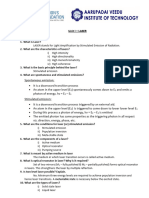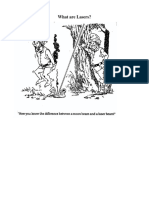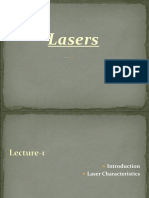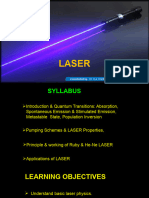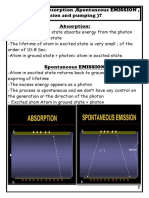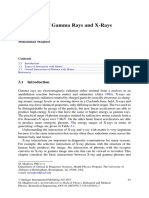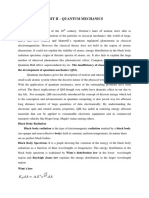Lasers
- Normal, incoherent light is created from thermal radiation while lasers use stimulated radiation, which
creates light by emitting photons by the absorption/passage of another photon.
- The photon that is emitted by stimulated emission is identical to the photon that triggered its emission, and
both photons can go on to trigger stimulated emission in other atoms, creating the possibility of a chain
reaction.
- In most materials, atoms or molecules drop out of excited states fairly rapidly, making it difficult or
impossible to produce a chain reaction. The materials chosen for lasers are the ones that have metastable
states, which stay excited for a relatively long time, called an active laser medium.
- Lasers are diffraction-limited and can be focused to a tiny point, so it has a high irradiance
- A gain medium or an active laser medium is a source of optical gain within a laser.
- Optical gain/amplification is where a medium transfers some of its potential energy to electromagnetic
radiation; causes an increase in optical power
- Includes certain crystals, typically doped with rare-earth ion; Glasses, e.g. silicate or phosphate
glasses, doped with laser-active ions; Gases, e.g. mixtures of helium and neon (HeNe);
Semiconductors, e.g. gallium arsenide (GaAs), indium gallium arsenide (InGaAs), or gallium nitride
(GaN).
- A metastable state is an intermediate energetic state within a
dynamical system other than the system's state of least energy.
- Like a local minimum of energy state
- A ball resting in a hollow on a slope is a simple example of
metastability. If the ball is only slightly pushed, it will settle
back into its hollow, but a stronger push may start the ball
rolling down the slope.
- Some atomic energy levels are metastable (Rydberg atoms: w/ electrons w/ high orbital quantum states)
- Transitions from metastable excited levels are typically those forbidden by electric dipole selection rules
(e.g. pauli exclusion, quantization). A
- Any transitions from a metastable level are relatively unlikely to occur. In a sense, an electron that
happens to find itself in a metastable configuration is trapped there. Since transitions from a metastable state
are not impossible (merely less likely), the electron will eventually decay to a less energetic state.
- Electrons at a metastable energy level would require a forbidden transition to get to a lower energy level.
- Electrons have a longer lifetime at a metastable level
- Before transitioning to a metastable state, an electron must be in an excited state (higher than metastable)
- Once a lot of electrons have reached a metastable state, spontaneous emission must happen for the laser to
work
- Once an electron undergoes the “forbidden” transition from metastable to ground state, stimulated emission
follows
- The wavelength of a laser is the amount of energy electrons release when they go back to ground state, which
equals the amount of energy needed to excite the electron to its metastable state.
- Helium and Neon are usually used together in laser gas chambers because they have almost the same energy
gaps between their metastable states and a lower state
� Lasers
- Lasers have a gain medium that increases the power of stimulated emission and contains something that gives
it feedback.
- Feedback enables stimulated emission to amplify predominantly the optical frequency at the peak of the
gain-frequency curve. As stimulated emission grows, eventually one frequency dominates over all others,
meaning that a coherent and monochromatic beam has been formed.
- Similar to what happens when a microphone is placed too close to a speaker; the screech that happens
is an oscillation from the speaker at the peak of the gain-frequency curve, dominating over
everything else
- For the gain medium to amplify light, it needs to be supplied with energy in a process called pumping.
- The energy is usually sourced from an electric current, but usually supplied from a flash lamp (very
short, electrostatic discharge that causes incoherent, full spectrum white light) or another laser
- Feedback is usually done through an optical cavity, which is an arrangement of two mirrors at the front and
back where photons bounce back and forth. One of the mirrors is partially transparent so light can escape from
it as the laser beam, which is called the output coupler.
- Types of lasers:
- Helium–neon (HeNe) laser uses an electrical discharge in the helium-neon gas mixture
- Nd:YAG laser uses either light focused from a xenon flash lamp or diode lasers
- excimer lasers use a chemical reaction.
� Scattering
Rayleigh Scattering
- Particles with a size much smaller than the wavelength of the radiation.
- For light frequencies well below the resonance frequency of the scattering medium (normal dispersion
regime), the amount of scattering is inversely proportional to the fourth power of the wavelength
- Happens for the particles in our atmosphere; responsible for blue sky and red sunsets
- Elastic scattering, i.e. no energy is gained or lost, only redirection
- Limit of Mie scattering: an approximation that only works for really small particles
- Lord Rayleigh (John William Strutt)
Mie Scattering
- Mie solution to Maxwell’s equation that describes the scattering of light (EM plane wave) by a homogeneous
sphere (uniform density)
- Aka non-molecular scattering or aerosol particle scattering
- Happens for water droplets in the lower 4500 m of our atmosphere when the size of a particle is similar to the
wavelength of light
- Common catalysts include dust, pollen, smoke and microscopic water droplets that form clouds
- Used in laser diffraction analysis to compute diffraction data and particle sizing stuff
- Responsible for white/gray clouds
- Gustav Mie
Brillouin Scattering
- Interaction of light with the matter waves in a medium, e.g. electrostriction and magnetostriction.
- Electrostriction is a property of a dielectric material that describes how much the material deforms
under an electric field. Caused by the displacement of ions, where position ions will be displaced in
the direction of the field and negative ions in the opposite direction.
- Magnetostriction is the same as above but for the magnetic field and caused by rotating domains.
- Materials for Brillouin scattering can be classified by either of the following, represented as a quasiparticle
- mass oscillation modes (called phonons, analogous to quantized sound waves)
- charge displacement modes (in dielectrics, called polarons)
- magnetic spin oscillation modes (in magnetic materials, called magnons)
- Inelastic scattering; photons either gain or lose energy.
- Stokes process: photons lose energy and emit one of the quasiparticle types
- Anti-stokes process: photons gaine energy by absorbing one of the quasiparticle types
- Brillouin shift is a detectable change in a photon’s energy after experiencing Brillouin scattering. Can be used
to detect the energy of quasiparticles.
- Rayleigh scattering may also occur alongside Brillouin scattering in less dense media but it is elastic so it
doesn’t affect energy.
- Leon Brillouin
� Scattering
Raman Scattering
- Inelastic (exchange of energy and change of direction). The vibrational state changes
- Rayleigh scattering and Raman scattering happen at the same time. Most are elastically, Rayleigh scattered,
and some are inelastically scattered through Raman scattering, with molecules gaining vibrational energy
- Raman Spectroscopy can be used to analyze spectra formed by Raman scattering, known as the Raman
shift, to identify molecules since each have a unique Raman shift associated with it. Scattering through casses
can also tell us the rotational energy.
- Gives information about the vibrational energy within a molecule, which is how much molecules oscillate
together around their center of mass (usually 1E13 to 1E14).
- When light is incident on a molecule, it will excite it to a virtual energy level (imaginary) and re-emission
can either lead to Rayleigh, Stokes, or anti-Stokes scattering depending on the vibrational state after
re-emission.
- Rayleigh scattering → stays the same
- Stokes-Raman scattering → increases
- Anti-stokes Raman scattering → decreases
- Sir Chandrasekhara Venkata Raman
- Molecules have normal vibrational modes
depending on the atomic mass of each
atom. All vibrational modes are detected at
once through Raman scattering, so we can
take a fourier transform to get the
individual frequencies, defending the
spectroscopic fingerprint of a molecule
Compton Scattering
- Inelastic; photons lose energy
- Scattering of photons by the ionization of atoms. When atoms absorb photons, it can eject outer valence
electrons that absorb energy from the photon, causing the photon to be scattered with less energy.
- In inverse compton scattering, the ejected particle can have more energy than the photon, which causes the
scattered photon to have more energy. This difference in energy/wavelength is called the Compton shift
- The low-energy limit of compton scattering is Thomson scattering
- Arthur Holly Compton
Thomson Scattering
- Elastic scattering
- Low-energy limit of compton scattering
- Happens when the photon energy is much smaller than the mass
energy of the photon: E = hf << mc2
- When an electromagnetic wave interacts with a charged particle,
it induces an oscillation of the particle which causes it to
accelerate, emitting its own polarized light strongest Amplitude
perpendicular to the acceleration and tends to 0 at the poles. proportional to
The light is polarized in the same direction as the charge’s cos(χ)
acceleration.



